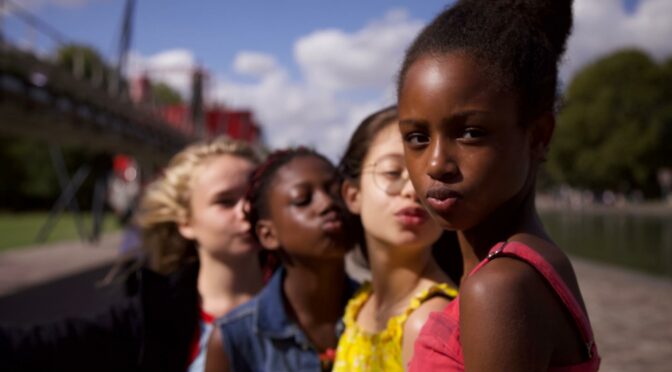 Adolescent struggles on film are a well-trodden path, but CUTIES (MIGNONNES) from Maïmouna Doucouré feels fresh and modern. That modernity often manifests in uncomfortable ways, but the authenticity of this portrait is evident. This personal story juggles several topics but the excellent performance of young Fathia Youssouf, in the challenging central role, provides a focal point for all of them.
Adolescent struggles on film are a well-trodden path, but CUTIES (MIGNONNES) from Maïmouna Doucouré feels fresh and modern. That modernity often manifests in uncomfortable ways, but the authenticity of this portrait is evident. This personal story juggles several topics but the excellent performance of young Fathia Youssouf, in the challenging central role, provides a focal point for all of them.
We follow Fathia Youssouf as Amy, a young French girl in Paris. She is being raised fairly traditionally in the Islamic faith by her mother Mariam (Maïmouna Gueye) while her father is absent, set to marry a second wife in Senegal, causing issues at home. After she spies Angelica (Médina El Aidi-Azouni) in her building’s laundry room, she is intrigued by her – dancing exuberantly and straightening her hair with an iron – while fearful of the group of Angelica’s friends. Although the group bully her, Amy gradually ingratiates herself with her dancing skills. The girls’ dancing routine – prepared for an upcoming competition – seem too provocative for pre-teens, and the group are also eager to demonstrate their growing awareness of their femininity by presenting themselves as worldly and sexually aware.
“Doucouré’s film places a tremendous amount of responsibility on Fathia Youssouf, who conveys the curiosity of youth as well as the confounding blend of determination and naivety one would expect of an 11-year-old.”
Doucouré’s film places a tremendous amount of responsibility on Fathia Youssouf, who conveys the curiosity of youth as well as the confounding blend of determination and naivety one would expect of an 11-year-old. Doucouré’s self-penned script is also the source of this, in addition to some observant modern embellishments to this vignette of accelerated childhood and the clash of cultures Amy experiences between her family and friends.
The story keenly positions the clashes presented to Amy during CUTIES to highlight the heightened sense of importance children attach to such exploits. The approaching dance competition takes on outsized importance to Amy, and the responsibilities to her mother and elderly aunt feel monumentally stifling. Doucouré’s direction and the actors combine to present the competing aspects of the girls’ actual maturity, their outward projection of it, and the external influences at play. The girls perform dance routines which allude to sex, yet will not recognise a condom in the grass. Amy will practice her dance routine in the bathroom, and the film will hard cut to her praying with her elders. Youssouf projects the artificiality of what young people present on social media, as a grin erupts on her face when the validation of ‘likes’ from her peers salves her self-consciousness. Far from being an austere affair, the film manages to elicit laughs at more than a few of such incidents and balances the tone effectively.
In a manner, CUTIES is also unflinching. The dancing routines choreographed by the girls make use of provocative manoeuvres that draw the disapproving glances of parents and observers – they are uncomfortable to watch, just as the passive encouragement of the judges is uncomfortable to see. At the same time, however, Amy’s burgeoning confidence (perhaps overconfidence) is also apparent. These sequences foreground the impact that role models have on the different modes of expression and identity that children, and young women, in particular, may pursue. When Amy feels stifled by her traditional upbringing, her path with Angelica’s group is the only one seemingly open to her.
“By the time the film concludes, it feels as though Amy may not be the only one who has begun to find balance and feel elevated – Maïmouna Doucouré maybe has also.”
The film is generally content to observe, maintaining a reasonably naturalistic approach to an authentic-feeling story. Although the decision to begin in media res is puzzling, CUTIES is a personal and assured tale with a skill for identifying the essence of pre-teen behaviour, particularly for a first feature. There are some nice visual touches, with Amy’s most childlike moments being the most colourful: playing with translucent green beads, the varied and dramatic lighting within a laser tag arena (albeit in the sort of environment already well-mined in cinema for such aesthetic qualities). However, the visual flourishes are generally saved for the film’s final movements as Amy’s worlds collide, the film making greater use of colour to convey the chaotic internal moods of its protagonist.
By the time the film concludes, it feels as though Amy may not be the only one who has begun to find balance and feel elevated – Maïmouna Doucouré maybe has also.
CUTIES premiered at the 2020 Sundance Film Festival and will be distributed by Netflix.

